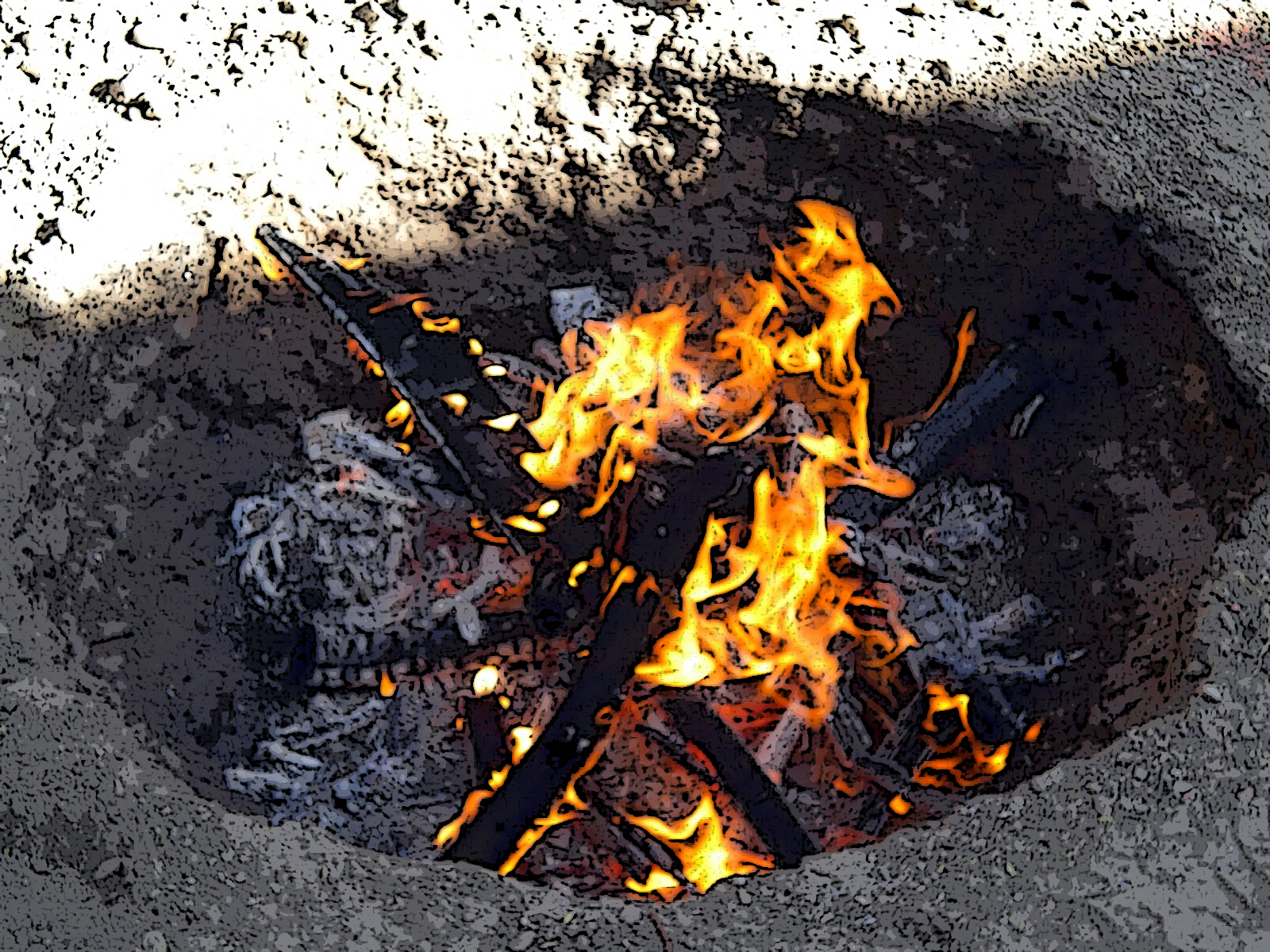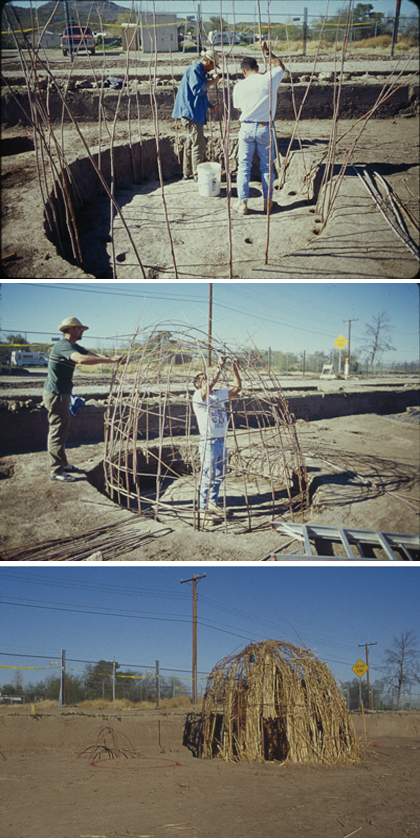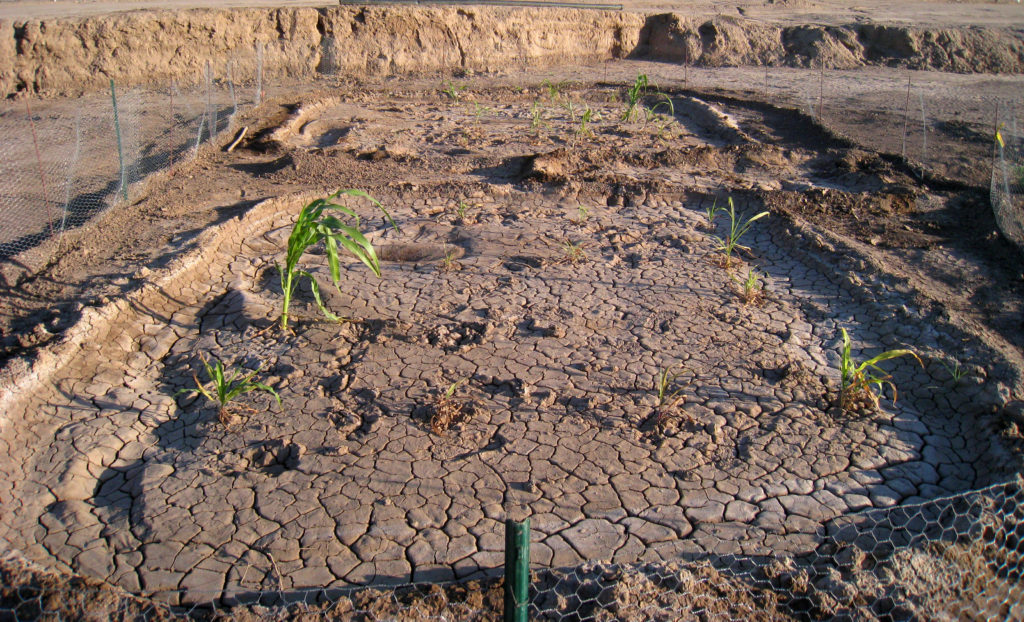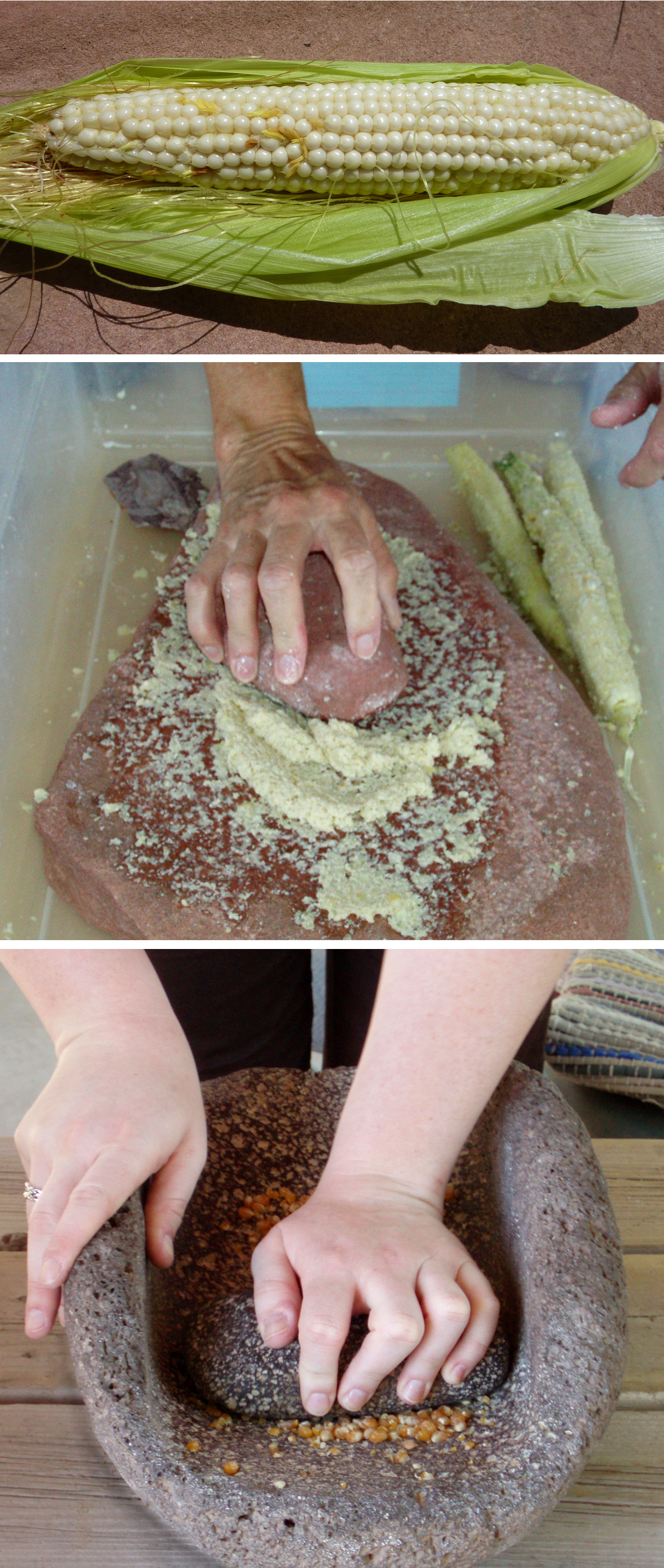
Experimental Archaeology: Learning by Doing
R. J. Sliva, who has done the compulsory lithics graduate student curing-hides-with-brains experiment, recounts the more informative experimental archaeology conducted by Desert staff.
Some men simply want to watch the world burn… particularly when it advances archaeological knowledge. Traditional technologies expert and long-time Desert associate Allen Denoyer led the team that built replica pithouses at Steam Pump Ranch in Oro Valley a few years ago. In the intervening time, Allen has observed the pithouse as it withstands sun, wind, and torrential monsoon downpours, occasionally making needed repairs to the roof and walls. In two weeks he will set one on fire and record how it burns and, most importantly for field archaeologists, what it looks like after it collapses back into the ground.

A Cienega phase pithouse replicated at the Clearwater site by Homer Thiel’s Desert Archaeology crew.
This exercise, aside from being fun and dramatic, is a great example of experimental archaeology: testing the performance of the materials, artifacts, and structures we observe in the archaeological record, and the behaviors we infer from them, by reconstructing and using them under carefully controlled conditions. Much as we gain one level of understanding from a driver’s education manual and another level entirely from driving a four-speed Triumph on the 405 at rush hour, replicating ancient tools and building copies of ancient structures gives us a more thorough understanding of sites and artifacts than theoretical study alone. With robust experimental pithouse data in hand, instead of simply seeing a stain in the soil or a hole in the ground, we can “read” the entire sequence of building, remodeling, and, ultimately, ruin.
Desert Archaeology investigations have benefited from a range of experiments conducted by our staff over the years. Some of these experiments have been built into project budgets, while others have happened on weekends in our back yards. Regardless of the setting, careful planning and recording are the keys to ending up with useful data.
Desert researchers have experimented with pithouse construction before. During our early 2000s excavations at the Clearwater site at the base of A-Mountain, on the west side of the Santa Cruz River in Tucson, a team led by Homer Thiel replicated a more ephemeral Cienega phase (c. 800 B.C.-A.D.50) pithouse. Compared to the massive rectangular Hohokam house at Steam Pump Ranch, these houses built by earlier Tucson Basin farmers were shallower, smaller, and round, supported by a network of slender branches instead of large beams, and likely often covered with plant material instead of a mud roof. This structure helped us answer questions about how much effort the houses took to build (not much) and how long they lasted before sustaining weather damage (not long). Houses like this would have been best suited for short-term use, perhaps while tending seasonal crops.

A reconstructed field plot and an irrigation canal built by Desert Archaeology crew at Las Capas.
This naturally leads to the issue of how this early crop-tending might have worked. Our recent investigations at Las Capas, on the north side of Tucson, uncovered a large (>15 acres) irrigated field system that was built during the late San Pedro phase (c. 930-800 B.C.) of the Early Agricultural period—the earliest agricultural fields yet discovered in North America. To address the questions of how many people would have been needed to build and maintain the fields and irrigation canals, and how many people could have been fed with the resulting crops, Jim Vint and Fred Nials dug a plot and irrigation ditch matching the design of the ancient field cells, and planted a strain of corn that is similar to the variety grown by the Tucson Basin’s first farmers. The answers? It was surprisingly easy to clear a small plot with raised edges, dig planting holes, and dig an irrigation channel, all using simple stick tools, even for two middle-aged men with dodgy backs. Extrapolating the caloric yield of the corn that successfully grew in the experimental plot to the entire 15-acre field system, Vint estimates that 46 to 111 people could be fed per year, depending on the proportion of their diet that was filled by corn.

Heirloom reventador maize (top), grinding green corn in a flat-to-concave metate (middle), grinding dried popcorn kernels in a trough metate (bottom).
Once the corn was grown, how did people prepare it for cooking and storage? We know that large ground stone tools were the primary technology people relied on when dealing with maize, but were the same tools used to process fresh green corn and dried kernels? Did it help to soak, parch, or pop different strains first? To address these questions, Desert’s Jenny Adams designed an ongoing experimental program, most recently with the help of Joyce Rychener, who specializes in growing heirloom crops at Steam Pump Ranch. Their Science Fridays, conducted with volunteers around pits dug on the edges of Desert’s office property, provided data linking specific corn varieties and processing methods to different ground stone tool designs. This allows Dr. Adams to infer ancient people’s dietary practices from observing the kinds of tools they used, and also provides an understanding of how much time people likely spent each day working to prepare harvested food.
Experimental archaeology is a great way to get the general public excited about and engaged in our work—people of all ages enjoy trying their hand at grinding corn in a metate, or seeing how far they can fling a stone-tipped spear. It also serves the very real purpose of making our analyses quicker and more efficient because they are more informed. Backed by experimental evidence, we have ready-made frameworks for evaluating data and recognizing patterns in the ground and in our assemblages. Understanding formation processes means that we can eliminate some scenarios at the outset and focus on supportable explanations. Just as important, if something unusual or unexpected pops up, we take notice. Experimental archaeology allows us to discern the different ways people might have responded to the challenges and opportunities presented by both their environment and available technologies, and that leads to a better final product.
Resources
Excavations and analyses of Las Capas
Early farming in the Tucson Basin
Food-grinding experiments (free site registration required)

